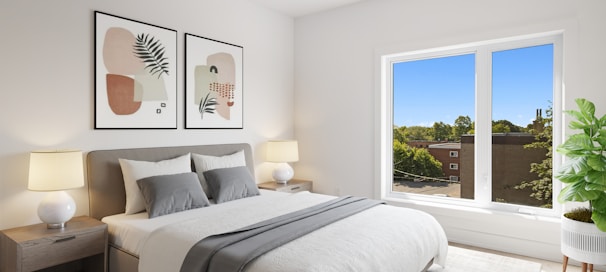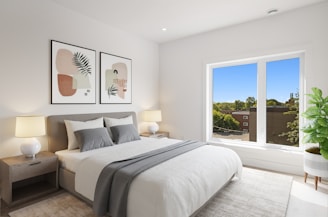Albuquerque Home Staging: Mastering Furniture Placement for Success
Elevate your Albuquerque home staging with expert furniture placement strategies. Avoid common staging mistakes and make your property irresistible to potential buyers.
Edgar Marroquin
10/28/20239 min read


Furniture Placement for Successful Home Staging
Introduction
The power of a compelling first impression is undeniable. One crucial factor that influences this initial impact is furniture placement—a defining element that shapes how prospective buyers perceive a property's space, light, and overall charm.
The art of furniture placement in the context of home staging plays a pivotal role in optimizing the perceived roominess and brightness of a space. It's all about making your home more appealing to those on the hunt for their next property. Despite its apparent complexity, professional home stagers adhere to a set of fundamental principles that can metamorphose even the most ordinary living areas into extraordinary showcases, attracting potential buyers.
This blog post will immerse you in these essential principles of furniture placement for effective home staging. These strategies have consistently elevated property desirability, accelerated sales, and increased market value. Let's explore how these guidelines can transform your living spaces into irresistible showpieces for potential buyers, enhancing your Albuquerque home staging experience.
Space and Furniture Relationship
Creating a focal point in each room holds immense importance. A well-positioned and visually striking focal point has the ability to captivate potential buyers, offering them a clear purpose and inspiration as they navigate through your property. These focal points can either be existing room features or thoughtfully selected pieces that anchor the room's overall design.
To pinpoint or establish a compelling focal point in any given room, one must consider the room's architecture, sources of natural light, and the flow of movement within the space. Elements like a splendid fireplace, a generously sized window with scenic vistas, a remarkable piece of art, or even a thoughtfully arranged collection of furniture can serve as potent focal points. Understanding the distinct attributes of each room and how to accentuate them is pivotal to successful home staging.
In the forthcoming sections, we'll delve into room-specific strategies for effective furniture placement in the context of home staging. We'll scrutinize how these principles are applied to living rooms, dining areas, and bedrooms, ensuring that each space unveils its complete potential, forging an irresistible allure for prospective buyers.
Creating a Stunning Living Space
When preparing your home for sale, the living room takes center stage as the heart of your home, where gatherings with family and friends happen.
Crafting Elegance with the Essentials
To make your living room shine, focus on carefully selecting and retaining essential pieces of furniture that complement the room's size and function. The "less is more" principle is your guiding light in home staging. Concentrate on the core elements: a stylish sofa, an inviting coffee table, an artful rug, a comfortable accent chair, and a well-placed media console. By emphasizing these fundamental pieces, you can create an atmosphere exuding elegance and spaciousness, leaving a lasting impression on potential buyers.
Balancing Proportions for Maximum Appeal
Proper furniture proportions are crucial for making a favorable impression. An overcrowded living room can discourage buyers, making the space feel cramped and less inviting. Pay close attention to the size of each piece. If any furniture in your living room seems too large or overwhelms the space, consider replacing them with more compact alternatives. This simple adjustment can work wonders, giving your living room a more open and inviting feel.
Thoughtful Furniture Placement for an Irresistible Atmosphere
Strategic furniture placement is the cornerstone of enhancing the visual appeal of your living room. To maximize the room's charm, position your furniture thoughtfully. Ensure no piece of furniture blocks natural light sources, especially windows, which can darken the room and diminish its appeal. Additionally, explore creative furniture placement, such as angling pieces and utilizing corners effectively, to create an inviting, well-lit ambiance. By carefully arranging your furniture, you can transform your living room into a space that feels open and visually enticing, leaving potential buyers captivated by its allure.
By adhering to these principles, you can effectively enhance the appeal of your living room, making it more marketable. Striking a balance between elegance and spaciousness is the key to creating a setting that welcomes potential buyers and sets the stage for a successful sale.
The Dining Room: A Space for Shared Moments
When preparing your home for sale, the dining room takes on special significance, as it's a space where cherished moments are shared with family and friends.
Enhancing the Dining Experience
The dining room holds a special place in the hearts of many. It's a space where family and friends come together for shared meals and cherished moments, making it a focal point of interest when preparing to sell your home.
Streamlining with Only the Essentials
To make your dining room captivating, begin by selecting and retaining only the essential dining room furniture that aligns with the room's size and purpose. The principle of "less is more" is your guiding star in home staging. Concentrate on the fundamental elements: an elegant dining table, comfortable chairs, and perhaps a sleek buffet or hutch. These core pieces create an atmosphere of sophistication and roominess, leaving a lasting impression on potential buyers.
Balancing Size for Optimal Appeal
Maintaining the right furniture proportions is essential for making a favorable impression. An overcrowded dining room can deter buyers, making the space feel cramped and less appealing. Pay close attention to the size of each piece. If any furniture appears too large or overwhelms the room, consider swapping it for more compact alternatives. This simple adjustment can work wonders, giving your dining room a more open and inviting feel.
Strategic Furniture Placement for a Welcoming Environment
Effective furniture placement plays a pivotal role in enhancing the visual appeal of your dining room. To maximize the room's charm, it's crucial to position your furniture thoughtfully. Ensure that no piece of furniture obstructs the natural flow of the room, allowing easy movement for both residents and potential buyers.
Creating Comfortable Dining Spaces
One key consideration for your dining room is the space around the dining table. You'll want to make sure there's enough room for comfortable seating and easy movement. A good rule of thumb is to leave at least 36 inches (3 feet) of space around the table to accommodate chairs and provide a comfortable dining experience. This allows guests to move in and out of their seats with ease, creating a welcoming atmosphere.
Consider innovative solutions for furniture placement, such as adapting the chandelier's location, swagging it, or even replacing it with a different light fixture, allowing you to optimize the dining table's placement. By thoughtfully reconfiguring your lighting and furniture, you can transform your dining room into a space that feels open and visually appealing, leaving potential buyers impressed by its ambiance.
By adhering to these principles, you can effectively elevate the appeal of your dining room, making it more marketable. Striking a balance between elegance and spaciousness is the key to creating an environment that welcomes potential buyers and sets the stage for a successful sale.
Optimizing Bedroom Layout for Potential Buyers
When staging your Albuquerque home, each bedroom presents an opportunity for potential buyers to envision themselves in a tranquil and inviting space.
Strategic Bed Placement for a Welcoming Atmosphere
Thoughtfully positioning the bed is essential to create an inviting environment that resonates with potential Albuquerque real estate buyers. Placing the bed against a solid wall allows them to visualize entering the room without feeling overwhelmed, fostering a sense of security and providing a restful sleep environment. Avoid placing the bed beneath a window or against a shared wall, as these arrangements can disrupt sleep and create discomfort. By strategically positioning the bed, you enhance the room's functionality and visual appeal, helping buyers to picture themselves living in the space.
Balancing Proportions for Serenity
Achieving proportionate balance in the bedroom is vital for creating an attractive space that potential buyers of Albuquerque homes can readily connect with. Avoid overcrowding, which may deter buyers by making the space feel cramped and less appealing. Consider the size of each piece of furniture; for example, a king-sized bed in a small bedroom might overwhelm the space, while a queen-sized bed could offer a more open and welcoming feel. Additionally, maintaining proportional spacing around the bed is essential. Leave enough room on either side to allow for easy movement and access, as well as space for nightstands, creating a comfortable and attractive environment for Albuquerque home staging.
Common Furniture Placement Mistakes
Avoiding Common Furniture Placement Mistakes is crucial for creating an inviting and marketable living space during your home staging process. By recognizing and avoiding these pitfalls, you can ensure that your Albuquerque home staging project stands out and appeals to potential buyers.
1. Excess Furniture
One of the most common mistakes in home staging is overloading a room with furniture. While you may love your eclectic collection, a cluttered living space can be a major turn-off for potential buyers. To create an atmosphere of spaciousness and elegance, focus on quality over quantity. It's better to have a few well-chosen and appropriately sized pieces rather than overcrowding the room with furnishings. Clearing excess furniture allows potential buyers to envision the space as their own, free from the distractions of a cluttered environment.
2. Not Enough Furniture
On the flip side, under-furnishing a room can also be a mistake in home staging. An empty room can leave potential buyers confused about its intended use. Each room should communicate a clear and evident function. For instance, a living room should feature a comfortable sofa, an area rug, and a coffee table, allowing buyers to imagine the room as a cozy space for relaxation and entertainment. Without enough furniture, questions may arise, and the room's potential may be lost on potential buyers.
3. Poor Traffic Flow
An essential aspect of successful home staging is guiding potential buyers through the space seamlessly. It's vital to ensure that walkways are clear, unobstructed, and wide enough for easy movement. Furniture should not block natural traffic patterns, and there should be ample space for people to move comfortably within the room. Keep in mind that creating a harmonious traffic flow contributes to a sense of spaciousness and functionality that appeals to potential buyers.
4. No Purpose to the Room
Every room in your home should have a clear and evident function when staging for sale. Without a defined purpose, potential buyers may be left wondering how to use the space, which can lead to confusion and reduced interest. For example, a bedroom should unmistakably appear as a bedroom, complete with a well-placed bed, nightstands, and appropriate lighting. Staging each room with a distinct purpose ensures that potential buyers can envision themselves living comfortably in your home.
5. No Focal Point
Focal points play a crucial role in the visual appeal of a room. Without a compelling central element, a space can lack significance and appeal. Whether it's a stunning piece of artwork, a beautifully designed fireplace, or a well-positioned piece of furniture, creating or showcasing a focal point adds interest and charm to a room. A successful focal point can captivate potential buyers, drawing them into the space and enhancing their overall impression of the home.
6. Furniture Spread Too Far Apart
Spacing and placement are essential factors in home staging. Furniture that's spread too far apart can create a disconnected and disjointed look. It's important to group furniture logically, ensuring that pieces work together to define functional areas within a room. Consider pairing or grouping items to create a harmonious atmosphere. The right balance of space and furniture placement enhances the room's overall appeal and invites potential buyers to envision themselves living in your home.
7. Illogical Placement
Home staging should prioritize practicality in furniture placement. Placing furniture in ways that disrupt the natural flow of the room or obstruct key architectural features is a common mistake. Consider how each room will be used and ensure that furniture is thoughtfully arranged to enhance the space. By avoiding illogical placement and embracing practical design, you can create an environment that resonates with potential buyers and helps your home stand out in the competitive Albuquerque real estate market.
Conclusion
Furniture placement is a pivotal factor in shaping potential buyers' perceptions of a property's space, light, and overall appeal, making it a game-changer in the real estate industry. One vital element in making that first impression shine is furniture placement, which has a significant impact on how potential buyers perceive a property's space, light, and overall appeal.
Effective furniture placement in home staging is the key to optimizing the perceived spaciousness and luminosity of a room. It's about making your home more inviting to those seeking their next property. While it may seem like a complex task, professional home stagers follow a set of fundamental guidelines that can transform even the most ordinary living spaces into extraordinary showpieces that draw in potential buyers.
Throughout this journey of exploring the principles of furniture placement for successful home staging, we've uncovered strategies that consistently enhance property appeal, expedite sales, and elevate market value. These principles have the power to turn your living spaces into irresistible showcases for potential buyers, making your Albuquerque home staging an exceptional experience.
To recap, we've learned about the significance of creating a focal point in each room, tips for establishing balance and harmony in furniture placement, and the common mistakes to avoid when staging your home. By adhering to these guidelines, you can elevate the appeal of your living spaces and ensure that they're more marketable.
Achieving a balanced, welcoming, and marketable home is the ultimate goal of any home staging endeavor. With the insights gained in this blog post, you're now equipped to create an environment that leaves a lasting impression on potential buyers, setting the stage for a successful sale.
Whether you're gearing up to sell your home or actively engaged in the home staging business, always bear in mind that the skill of furniture placement is a game-changer. This artful technique wields the power to metamorphose your living spaces into captivating, well-lit, and highly marketable environments, guaranteeing that your property shines amid the fierce competition of the Albuquerque real estate market.
🌟 Ready to transform your space for a successful sale? Schedule your Home Staging Consultation with us today and let's turn your property into an irresistible gem! 🏡




